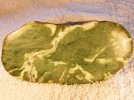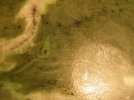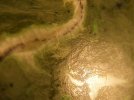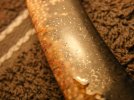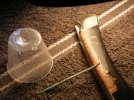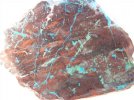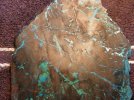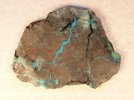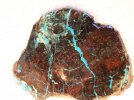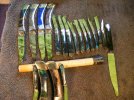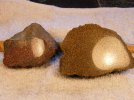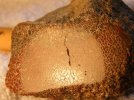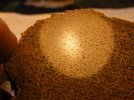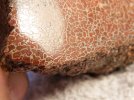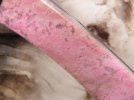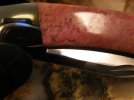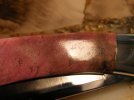- Joined
- May 21, 2007
- Messages
- 1,432
I often write, talk and chat about "texture" in stone. I will comment that a specific knife has a bit worse "texture" or less "texture" than others I have done with the same stone. Depending on the stone the "texture" I am referring too may be of different types too which does complicate matters.
So, I thought I would start a thread about this as I personally find it very interesting and my attempts to defeat the causes and appearance of "texture" is a really big aspect of my artistic sense and drive to get the best results from any given stone I use.
I think the best way to explain this is to compare natural stone to another natural material everyone can look over - wood. In wood "texture" can be the big structures that show such as knots and checks. These would compare to pits, vugs and lines in stone. In stone these are caused by many variable events but mostly by deposit of dissolved minerals over periods of time up to millions of years or fast moving events such as earthquakes, volcanic eruptions or floods. These natural occurring structures in stone allow for the deposit of new layers or lines that lead down into the stone that feed in new minerals that affect color, designs or even hardness.
End cut grain is another aspect of wood where the growth rings have different structures and harness. In stone these can be lines or rows of tiny pits and again are conduits that allow mineralization of things such as layers of mud that become silicate stones such as Agates, Jaspers and even Flint.
On quarter sawn wood you get grain that allows the surface to appear to be a glossy polish but at an angle to the light you can see a lot of "texture" that is the grain of the wood and even tiny voids if the wood has been finished with an oil finish. In stone this is very common if you look close and at the right angle.
So, I thought I would start a thread about this as I personally find it very interesting and my attempts to defeat the causes and appearance of "texture" is a really big aspect of my artistic sense and drive to get the best results from any given stone I use.
I think the best way to explain this is to compare natural stone to another natural material everyone can look over - wood. In wood "texture" can be the big structures that show such as knots and checks. These would compare to pits, vugs and lines in stone. In stone these are caused by many variable events but mostly by deposit of dissolved minerals over periods of time up to millions of years or fast moving events such as earthquakes, volcanic eruptions or floods. These natural occurring structures in stone allow for the deposit of new layers or lines that lead down into the stone that feed in new minerals that affect color, designs or even hardness.
End cut grain is another aspect of wood where the growth rings have different structures and harness. In stone these can be lines or rows of tiny pits and again are conduits that allow mineralization of things such as layers of mud that become silicate stones such as Agates, Jaspers and even Flint.
On quarter sawn wood you get grain that allows the surface to appear to be a glossy polish but at an angle to the light you can see a lot of "texture" that is the grain of the wood and even tiny voids if the wood has been finished with an oil finish. In stone this is very common if you look close and at the right angle.

